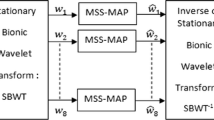Abstract
A new method is presented for the purpose of improving pass/fail separation during transient evoked otoacoustic emission (TEOAE) hearing screening. The method combines signal decomposition in scales using the discrete wavelet transform, non-linear denoising and scale-dependent time windowing. The cross-correlation coefficient between two subaveraged, processed TEOAE signals is used as a pass/fail criterion and assessed in relation to the pure-tone, mean hearing level. The performance is presented in terms of receiver operating characteristics for a database of 5214 individuals. The results show that the specificity improves from 68% to 83% at a sensitivity of 90% when compared with the conventional wave reproducibility parameter.
Similar content being viewed by others
References
Brass, D., Watkins, P., andKemp, D. T. (1994): ‘Assessment of an implementation of a narrow band, neonatal otoacoustic emission screening method’,Ear Hearing,15, pp. 467–475
Bray, P. (1989): ‘Click evoked otoacoustic emissions and the development of a clinical otoacoustic hearing test instrument’. PhD thesis, University of London
Daubechies, I. (1992): ‘Ten lectures on wavelets’ (SIAM)
Davis, A., Lutman, M., Grandori, F., andProbst, R. (1998): ‘European consensus statement on neonatal hearing screening’,ENT News,7 (http.//ent-news.com/)
Dirckx, J. J. J., Daemers, K., Somers, T., Offeciers, F. E., andGovaerts, P. J. (1996): ‘Numerical assessment of TEOAE screening results: currently used criteria and their effect on TEOAE prevalence figures’,Acta otolaryng.,116, pp. 672–679
Donoho, D. L., andJohnstone, I. M. (1992): ‘Minimax estimation via wavelet shrinkage’. Technical Report 402, Stanford University, Department of Statistics
Donoho, D. L., andJohnstone, I. M. (1995): ‘Adapting to unknown smoothness via wavelet shrinkage’,J. Am. Stat. Ass.,90, p. 432
Engdahl, B. (1998): ‘Otoacoustic emissions as a function of age, gender and hearing loss in a large general adult population’. Proc. AHEAD Eur. Meeting: Psychoacoust. and OAEs, Basel, 1998
Gorga, M. P., Neely, S. T., Bergman, B. M., Beauchaine, K. L., Kaminski, J. R., Peters, J., Schulta, L., andJesteadt, W. (1993): ‘A comparison of transient-evoked and distortion product otoacoustic emissions in normal-hearing and hearing-impaired subjects’,J. Acoust. Soc. Am.,94, pp. 2639–2648
Grandori, F., Cianfrone, G., andKemp, D. (1990): ‘Cochlear mechanisms and otoacoustic emissions’,Adv. Audiol.,7, pp. 99–109
Janušauskas, A., Engdahl, B., Svensson O., andSörnmo, L. (1999): ‘Latency of otoacoustic emission frequency components’,Med. Biol. Eng. Comput.,37, (Suppl. 1), pp. 332–333
Kemp, D. T. (1978): ‘Stimulated acoustic emissions from within the human auditory system’,J. Acoust. Soc. Am.,64, pp. 1386–1391
Lutman, M. E. (1993): ‘Rehable identification of click-evoked otoacoustic emissions using signal processing techniques’,Brit. J. Audiol.,27, pp. 103–108
Mallat, S. (1989): ‘Multresolution approximation and wavelets’,Trans. Am. Math. Soc.,315, pp. 69–88
Marozas, V., Janušauskas, A., Engdahl, B., Svensson, O., andSörnmo, L. (1999): ‘Detection of otoacoustic emission in wavelet domain’,Med. Biol. Eng. Comput.,37, (Suppl. 1), pp. 334–335
Neely, S. T., Norton, S. J., Gorga, M. P., andJesteadt, W. (1988): ‘Latency of auditory brain stem responses and acoustic emissions using tone-burst stimul.’,J. Acoust. Soc. Am.,83, pp. 652–656
Prieve, B. A., Gorga, M. P., Schmidt, A., Neely, S., Peters, J., Schultes, L., andJesteadt, W. (1993): ‘Analysis of transient-evoked otoacoustic emissions in normal-hearing and hearing-impaired ears’,J. Acoust. Soc. Am.,93, pp. 3308–3319
Ravazzani, P., Tognola, G., Grandori, F., andRuhonen, J. (1998): ‘Two-dimensional filter to facilitate detection of transient-evoked otoacoustic emissions’,IEEE Trans.,BME-45, pp. 1089–1096
Robinette, M., andGlattke, T. (1997): ‘Otoacoustic emissions: clinical applications’, (Thieme, New York)
Strang, G., andNguyen, T. (1996): ‘Wavelets and filter banks’ (Wellesley-Cambridge Press)
Tognola, G., Ravazzani, P., andGrandori, F. (1998): ‘Wavelet analysis of transient-evoked otoacoustic emissions’,IEEE Trans. BME-45, pp. 686–697
Weaver, J. B., Hansun, X., Healy, D. M., andCromwell, L. D. (1991): ‘Filtering noise from images with wavelet transforms’,Magnet. Res. Med.,21, pp. 288–295
Whitehead, M. L., Jimenez, A. M., Stagner, B. B., McCoy, M. J., Lonsbury-Martin, B. L., andMartin, G. K. (1995): ‘Time windowing of click evoked otoacoustic emissions to increase signal-to-noise ratio’,Ear Hearing,16, pp. 599–611
Author information
Authors and Affiliations
Corresponding author
Rights and permissions
About this article
Cite this article
Janušauskas, A., Marozas, V., Engdahl, B. et al. Otoacoustic emissions and improved pass/fail separation using wavelet analysis and time windowing. Med. Biol. Eng. Comput. 39, 134–139 (2001). https://doi.org/10.1007/BF02345277
Received:
Accepted:
Issue Date:
DOI: https://doi.org/10.1007/BF02345277




